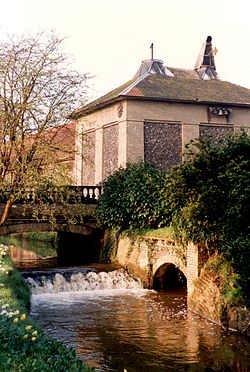
Cascade Brewery is a brewery established in 1824 in South Hobart, Tasmania and is the oldest continually operating brewery in Australia.

In brewing, adjuncts are unmalted grains or grain products used in brewing beer which supplement the main mash ingredient. This is often done with the intention of cutting costs, but sometimes also to create an additional feature, such as better foam retention, flavours or nutritional value or additives. Both solid and liquid adjuncts are commonly used.

Snape Maltings is an arts complex on the banks of the River Alde at Snape, Suffolk, England. It is best known for its concert hall, which is one of the main sites of the annual Aldeburgh Festival.

Mash ingredients, mash bill, mashbill, or grain bill are the materials that brewers use to produce the wort that they then ferment into alcohol. Mashing is the act of creating and extracting fermentable and non-fermentable sugars and flavor components from grain by steeping it in hot water, and then letting it rest at specific temperature ranges to activate naturally occurring enzymes in the grain that convert starches to sugars. The sugars separate from the mash ingredients, and then yeast in the brewing process converts them to alcohol and other fermentation products.
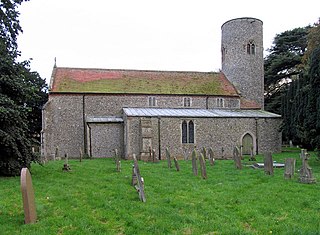
Letheringsett with Glandford is a civil parish in the English county of Norfolk. It includes the village of Letheringsett, along with the hamlet of Glandford. The village straddles the A148 King’s Lynn to Cromer road. Letheringsett is 1.2 miles west of Holt, 32.2 west north east of King’s Lynn and 126 miles north north east of London. The nearest railway station is at Sheringham for the Bittern Line which runs between Sheringham, Cromer and Norwich. The nearest airport is Norwich International Airport.

The River Glaven in the eastern English county of Norfolk is 10.5 miles (16.9 km) long and flows through picturesque North Norfolk countryside to the North Sea. Rising from a tiny headwater in Bodham the river starts 2½ miles before Selbrigg Pond where three small streams combine. The scenic value of the Glaven valley is important to the tourist industry in North Norfolk. The river is one of over 200 chalk rivers in the world and one of 160 in the UK.

Herbert Hardy Cozens-Hardy, 1st Baron Cozens-Hardy, (1838–1920) was a British politician and judge who served as Master of the Rolls from 1907 until 1918.

The A148 is an English A road entirely in the county of Norfolk. It runs from King's Lynn to Cromer via Fakenham, which it bypasses to the north.
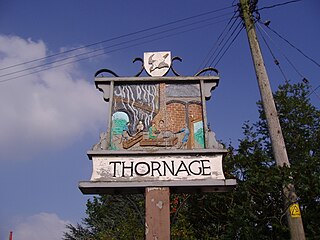
Thornage is a village and a civil parish in the English county of Norfolk. The village is 2.7 miles south-west of Holt, 23.2 miles north-west of Norwich and 11.3 miles east of Fakenham, and straddles the B1110 road between Holt and Guist. The nearest railway station is at Sheringham for the Bittern Line which runs between Sheringham, Cromer and Norwich. The nearest airport is at Norwich International Airport.

Alvinne is a small brewery in the hamlet of Moen near the Belgian city of Zwevegem.
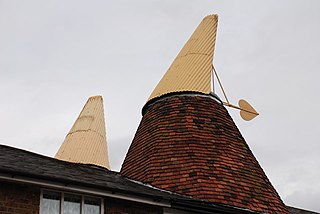
A cowl is a device used on a kiln to keep the weather out of and to induce a flow of air through the kiln. They are normally associated with oasts but can also be found on breweries, maltings and watermills.

Letheringsett watermill is situated on the River Glaven in the village of Letheringsett within the English county of Norfolk. Letheringsett is in the district of North Norfolk and is 1.4 miles (2.3 km) west of the town of Holt. The watermill is a Grade II* listed building and is the last fully operational watermill in Norfolk that produces flour.

Glandford watermill is situated on the River Glaven a little north of the village of Glandford within the English county of Norfolk. Glandford is in the civil parish of Wiveton within the district of North Norfolk.
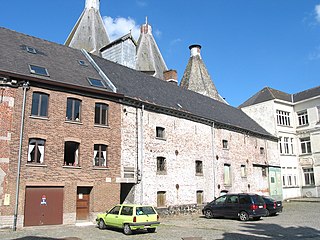
A malt house, malt barn, or maltings, is a building where cereal grain is converted into malt by soaking it in water, allowing it to sprout and then drying it to stop further growth. The malt is used in brewing beer, whisky and in certain foods. The traditional malt house was largely phased out during the twentieth century in favour of more mechanised production. Many malt houses have been converted to other uses, such as Snape Maltings, England, which is now a concert hall.
Jeremiah James Colman was an English mustard manufacturer and the third member of the family in charge of the eponymous company Colman's. He was a popular philanthropist in his home town of Norwich and a Liberal politician who represented the city in parliament.

Union Mills or Roy's Mills are a Grade II listed combined tower mill and watermill at Burnham Overy, Norfolk, England which has been converted to residential accommodation.
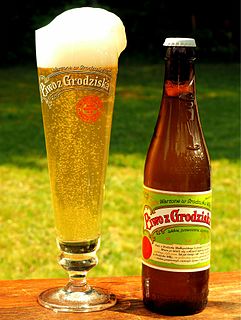
Grodziskie is a historical style of beer from Poland that is typically made from oak-smoked wheat malt. The beer can be described as having a clear, light golden color, high carbonation, low alcohol content, low to moderate levels of hop bitterness, and a strong smoke flavor and aroma. The taste is light and crisp, with primary flavors coming from the smoked malt, the high mineral content of the water, and the strain of yeast used to ferment the beverage. The beer was nicknamed "Polish Champagne" because of its high carbonation levels, and because it was valued as a high-quality beverage to be used for special occasions.
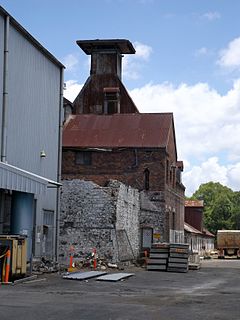
Toowoomba Maltings is a heritage-listed malthouse at 11 Mort Street, Newtown, Toowoomba, Toowoomba Region, Queensland, Australia. It was built from 1899 to 1907. It is also known as Black Gully Malthouse, Darling Downs Malting Company Ltd, Paterson Redwood and Co, Queensland Brewery Co, Carlton Maltings, Northern Australia Brewers Ltd, Queensland Malting Company Ltd, Redwood's Maltings, State Wheat Board, and William Jones and Son (Maltsters) Ltd. It was added to the Queensland Heritage Register on 21 January 1998.

The Bass Maltings in Sleaford, England are a large group of eight disused malt houses originally owned by the Bass Brewery of Burton upon Trent. Constructed between 1901 and 1907 to Herbert A. Couchman's design, the maltings are the largest group of malt houses in England; they have been designated Grade II* on the National Heritage List for England, recognising them as "particularly important ... of more than special interest."

Mary Hardy was an 18th-century English diarist. She depicted commercial and working life in the countryside, being actively engaged in her husband's farming and brewing business. Her 500,000-word record, compiled daily from 1773 to 1809, reveals the exacting, time-pressured nature of pre-mechanised work for the middle and labouring classes.
